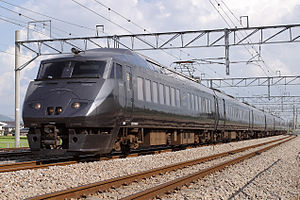787 series
| 787 series | |
|---|---|

787 series set BM5 on the Kagoshima Main Line, September 2009
|
|
| In service | July 1992–Present |
| Manufacturer | Hitachi, Kinki Sharyo |
| Built at | Kudamatsu, Higashiōsaka |
| Replaced | 485 series |
| Constructed | 1992 - 2002 |
| Number in service | 140 vehicles (26 sets) |
| Formation | 4/6/7 cars per trainset |
| Fleet numbers | BM1-15, BM101-111 |
| Operator(s) | JR Kyushu |
| Depot(s) | Ōita, Minami-Fukuoka |
| Specifications | |
| Car body construction | Steel |
| Car length | 21,200 mm (end cars) 20,000 mm (intermediate cars) |
| Width | 2,944 mm |
| Doors | 1 per side |
| Maximum speed | 130 km/h (80 mph) |
| Traction system | Thyristor drive |
| Electric system(s) | 20 kV AC 60 Hz |
| Current collection method | Overhead catenary |
| Bogies | DT400K(powered), TR400K(trailer) DT901K(powered), TR901K(trailer)(prototype bogie) |
| Safety system(s) | ATS-SK |
| Track gauge | 1,067 mm (3 ft 6 in) |
The 787 series (787系) is an AC electric multiple unit type operated on limited express services by Kyushu Railway Company (JR Kyushu) in Japan since July 1992.
The trains were built jointly by Hitachi and Kinki Sharyo.
The 7-car sets are formed as follows.
Cars 2 and 7 are each fitted with one PS400K scissors-type pantograph.
The two 6-car sets are formed as follows.
Cars 2 and 6 are each fitted with one PS400K scissors-type pantograph.
The 11 4-car sets are formed as follows.
Car 3 is fitted with one PS400K scissors-type pantograph.
As of March 2011, the 787 series are used on the following limited express services.
From the start of the revised timetable on 12 March 2011, with the completion of the Kyushu Shinkansen, 787 series sets will no longer be used on Relay Tsubame services. The T1 (SaHa 787) cars will be removed from the 7-car sets to form a fleet of 15 6-car sets. These will be used on Kamome services, displacing the earlier 783 series EMUs.
All cars were made no-smoking from the start of the revised timetable on 18 March 2007.
...
Wikipedia
